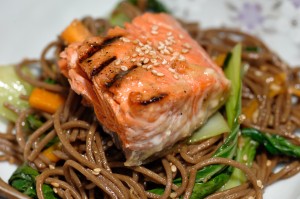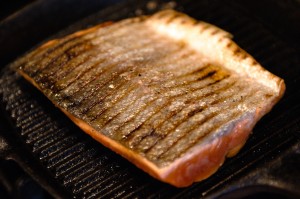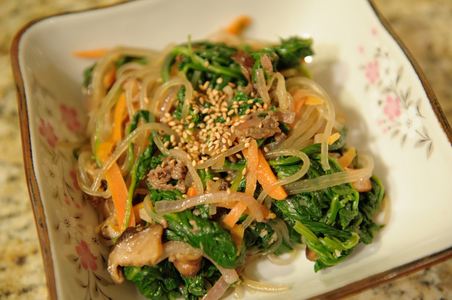
I know some people give up meat on Fridays, especially during Lent, so to celebrate the end of Lent, the coming of Easter, and the arrival of Spring, I have a fresh and tasty fish recipe for you!
The two “ethnic” ingredients you’ll need for this recipe are both Japanese. Soba noodles are thick, chewy buckwheat noodles, with a wonderful nutty taste. They come dried and are widely available, so if your grocery store has an Asian section, there’s a good chance they’ll be there. (You could substitute whole wheat spaghetti if you really can’t find the soba noodles.) The other ingredient is miso paste. It’s made of fermented soy beans and adds a mild soy sauce-like flavor. Check the refrigerated section of the store, maybe by the tofu. (If you can’t find it, use soy sauce instead, but the flavor will be more pronounced.) As for the vegetables, I like baby Bok Choi, but if you can’t find that, you could use 5 ounces of spinach instead, or Napa cabbage, or even bean sprouts and strips of bell pepper. Be creative! This recipe serves two, but you can easily double it if you like.
Soba Noodles with Salmon and Miso
(Adapted from a recipe in the book Homestyle Asian)
Ingredients:
- 2 ounces dried soba noodles
- 1 heaping teaspoon miso paste (or one teaspoon soy sauce)
- 3 tablespoons honey
- 4 teaspoons sesame oil, divided
- 1 pound salmon filets
- 1 teaspoon chopped fresh garlic (use 2 cloves)
- 1 tablespoon grated fresh ginger
- 1 carrot, cut into matchsticks
- 3 green onions, thinly sliced
- 4 heads of baby bok choi, separated into individual leaves (or use one 5 ounce bag baby spinach)
- 2 tablespoons rice vinegar
- 1 tablespoon soy sauce
- 1 tablespoon sesame seeds

Directions:
- Preheat the oven to 350*F. Cook the soba noodles according to the package directions. Drain, add back to the pot you cooked them in, and toss with a teaspoon of the sesame oil, so the noodles won’t stick together. Set aside.
- Whisk together the miso, honey, one teaspoon sesame oil, and one teaspoon water to form a paste. Brush over the salmon. Sear on a hot grill pan or frying pan for 30 seconds. Brush salmon with any remaining glaze and place on a foil-lined baking tray. Bake for 6 minutes, then cover and leave to rest in a warm place.
- Heat one teaspoon of sesame oil in a frying pan. Add the garlic, ginger, carrot, green onion, and bok choi and sauté for one minute. The vegetables should not brown, but remain bright and crisp. Add the noodles, rice vinegar, soy sauce, and last teaspoon of sesame oil, and stir to combine for another 30 seconds.
- To serve, place the noodles and vegetables on the plate. Top with salmon and sprinkle with sesame seeds.
Explore, experiment, enjoy! — Dana
*****
To view even more of Dana’s unique recipes, you can visit her at Frugal Girlmet!




